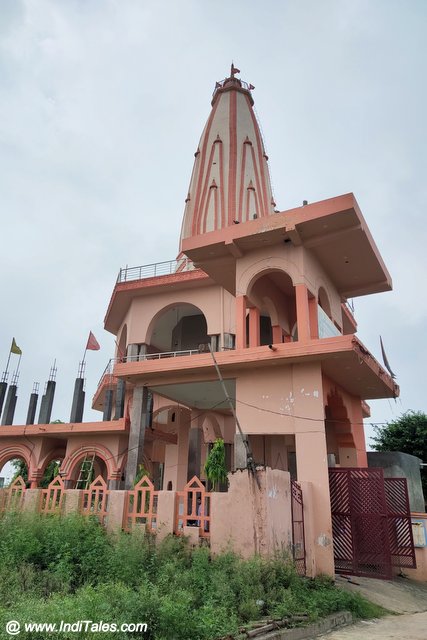Bisrakh gets its name from Rishi Vishwashrva, that must have got distorted over time. We better know him as the father of ten headed Ravana, the one who ruled golden Lanka. Some accounts say that he was born here while others say that he spent a part of his childhood here.
Bisrakh is an ancient village located in the urban metropolis of Noida. Technically it is Sector 1 of Greater Noida. From Delhi, it may be 20-30 kms, depending on where you start from.
Visiting Bisrakh
It took us 15–20-minute drive on swanky expressway roads of Noida and Greater Noida to reach Bisrakh.
The first thing we noticed here was a grocery store called Ravan Kirana Store. Right next to it, Ravan DJ announced its presence in a garage. This was my introduction to the living legend of Ravana in the village. Opposite the shop was a fairly large Anami Dham Ashram.
We spoke to the Kirana store owner and asked him for directions to the temple of Ravana. We were told to follow a lane through the village. It was a narrow lane, but we could see large well-maintained houses on either side.
On the other side of the narrow lanes, we reached a patch of wilderness, amidst which stood a temple with a tall shikhara. However, this is not the temple we were searching. That was a little ahead to our left.
Ancient Shiva Temple at Bisrakh
We entered through an arch and between the ornate temple entrance and us stood a lone tree. The temple prakara or the boundary wall is being built with stories from the life and times of Ravana.

We walked around and met the artisans who were sculpting an image of Vibhishan, Ravan’s younger brother on the side wall. They have come from Odisha for this project. My mind went back to the stone carvers of Odisha I had met in Jajpur.
You can prominently see the 10 headed Ravana on the right of the door. On the left you can see, Rishi Vishwashrva worshipping Brahma, he and his wife praying together and Ravana offering his head to Shiva. Scenes of his brothers Vibhishan and Kumbhakaran were being sculpted when we visited.

On top of the entrance doorway is a large sculpture of Ganesha in sitting position. On his either side is Lakshmi riding an owl and Saraswati riding a swan. There are sculptures of Rishis blowing the conch and some Naga sculptures.
We entered the temple compound which is big compared to the small temple that is just a small room built around a Shivalinga. A small Nandi in black stone sits in the open compound. A pale pink structure surrounds the main linga.
It is believed that Rishi Vishwashrva discovered a linga in the forest here that he installed and worshipped here. So, the linga is Swayambhu or self manifested.

Since it was the month of Shravan that is sacred for Shiva devotees, we saw a lot of people come and offer the Jalabhishek or water abulations to the linga. A lady with her face covered with her Dupatta was sitting and meditating next to the Shivalinga. Her presence added to the divine aura of the temple.
Linga looks old and has a Naga in metal surrounding it. I could see its octagonal shaft. It looks like it was installed inside a Yoni once but now stands alone embedded in granite tiles.

In a niche in the wall, there is small but stunningly beautiful Murti of Devi along her sons Ganesha and Kartikeya.
Navagraha Temple
Next to Shiva temple stands a small open temple dedicated to Navagraha or the nine planets. The Murti of Sun is very unique here. It shows the single wheel chariot of Sun being driven by two horses, who occupies the centre of Navagraha mandala.

A Murti of Yama overlooks the Navagraha Murtis. Murtis look old and one of them broken.
Vishwashrva Temple
Next to the Navagraha temple, there is long room that has the life size Murtis of all the deities. The unique Murti here is of course of Rishi Vishwashrva who is seated in front of a Shivalinga.

I found a beautiful Murti of Sun with seven horses in black stone, right next to the Murti of Vishvashrva Ji. This reminded me of the Surajkund that is not too far from here.
Other deities include:
Gauri Shankar along with Ganesha and Kartikeya
Kalki Bhagwan riding a white horse
Lakshmi Narayana
Kuber – remember he was the half brother of Ravana
Radha Krishna
Baba Mohan Ram ji riding a horse
Hanuman ji
Ma Kali
Who is Baba Mohan Ram ji? Well, he is the saint who is renovating this temple and Bisrakh Dham as it is called. He has a lots of devotees in the village as I gathered in my limited interactions.
Shiva Parvati Mandir
After visiting the main temple, we visited the temple with a tall Shikhara in bright pink color. It is again a small temple with a Devi Murti that was behind an iron cage.

Around the temple, few men were doing Mantra Japa.
On the side there were Murtis with oodles of prasad offered to them.
Festivals
In North India, Dussehra is celebrated by burning effigies of Ravana along with brother Kumbhakaran and son Meghnad.
However, Bisrakh being a village of Ravan, Dussehra is celebrated by worshipping Ravana. No Ramlila performances take place here. Even the Diwali celebrations are minimal and subdued.
This makes this a unique island in the Ramayana Landscape of Indian Subcontinent.
Travel Tips
Bisrakh is pretty much in the National Capital Region, so you can easily reach it.
Temple is open through the day.
I did not see any facilities for tourists as the temple is primarily used by locals.
Walk around the village that is like any other urban village yet unique.
